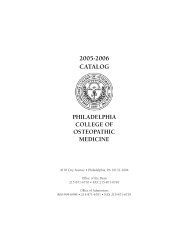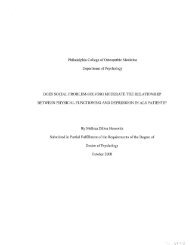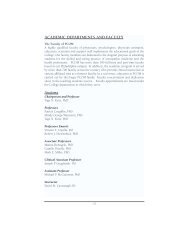0 - Philadelphia College of Osteopathic Medicine
0 - Philadelphia College of Osteopathic Medicine
0 - Philadelphia College of Osteopathic Medicine
Create successful ePaper yourself
Turn your PDF publications into a flip-book with our unique Google optimized e-Paper software.
BiopsychosociaJ Effects Among Coronary Artery Bypass Grafting Patients 12<br />
impacts (,ABG outcomes. The literature reports that those with lowered HRQL also show<br />
!cnver coping response and increased depression (McCabe, Schneiderman, Field, &<br />
Wellens. 2000). Some studies even indicate that patients who do not show improved<br />
quality <strong>of</strong> life measure higher pain scores (Fraguas, et aI., 2(00).<br />
In order to reduce these negative effects, research indicates that psychological<br />
intervention has inherent value in reducing a patient's distress and suffering, leading to<br />
improved HRQL. Interventions that fi.)cus on increasing a patient's social support and<br />
coping in response to pain and depression may show improved health related quality <strong>of</strong><br />
life and better outcomes (S;:umon, Mikhail, Stanford, Zeilinski, & Pepper, 1998;<br />
Rumsfelcl, Magdid, & 0 'Brien, 2001 ; Mittag et a1., 2001; Welke. et al., 2003).<br />
The relationship <strong>of</strong> psychosocial factors in current research has been considered<br />
only within the scope <strong>of</strong>impact on the individual. Fmiher research is needed to gather<br />
infonnation on the mechanism <strong>of</strong> variables such as perceived pain, depression and HRQL<br />
(Kmlsson, Berglin, Petttel'son, & Larsson, 1999; Shen, McCreary, & Meyers, 2004; Ben<br />
Zur, Rappaport, Ammar, & Uretzky, 2(00).<br />
The importance qlmeasuring HQRL. As previously supported, lower mortality<br />
and increased health care cost are contributing psychosocial factors among specific<br />
coronary disease states (Goodman, 1998). In fact, recent reviews question methodology in<br />
measuring HRQL and have been calling for continued designs that i()cus on the process<br />
<strong>of</strong> these variables with respect to outcomes in coronary patients, in particular, CABG<br />
. patients (Fitzpatrick, 2000; Bennet et a1., 2002; Juenger, et a1., 2002).<br />
Patient care has changed in the last several years to become multidisciplinmy.<br />
Patients recovering from CABG surgery are utilizing a nwnber <strong>of</strong> systems, a number <strong>of</strong><br />
pr<strong>of</strong>essionals, ,md various treatment interventions. In assessing problems [Uld establishing






